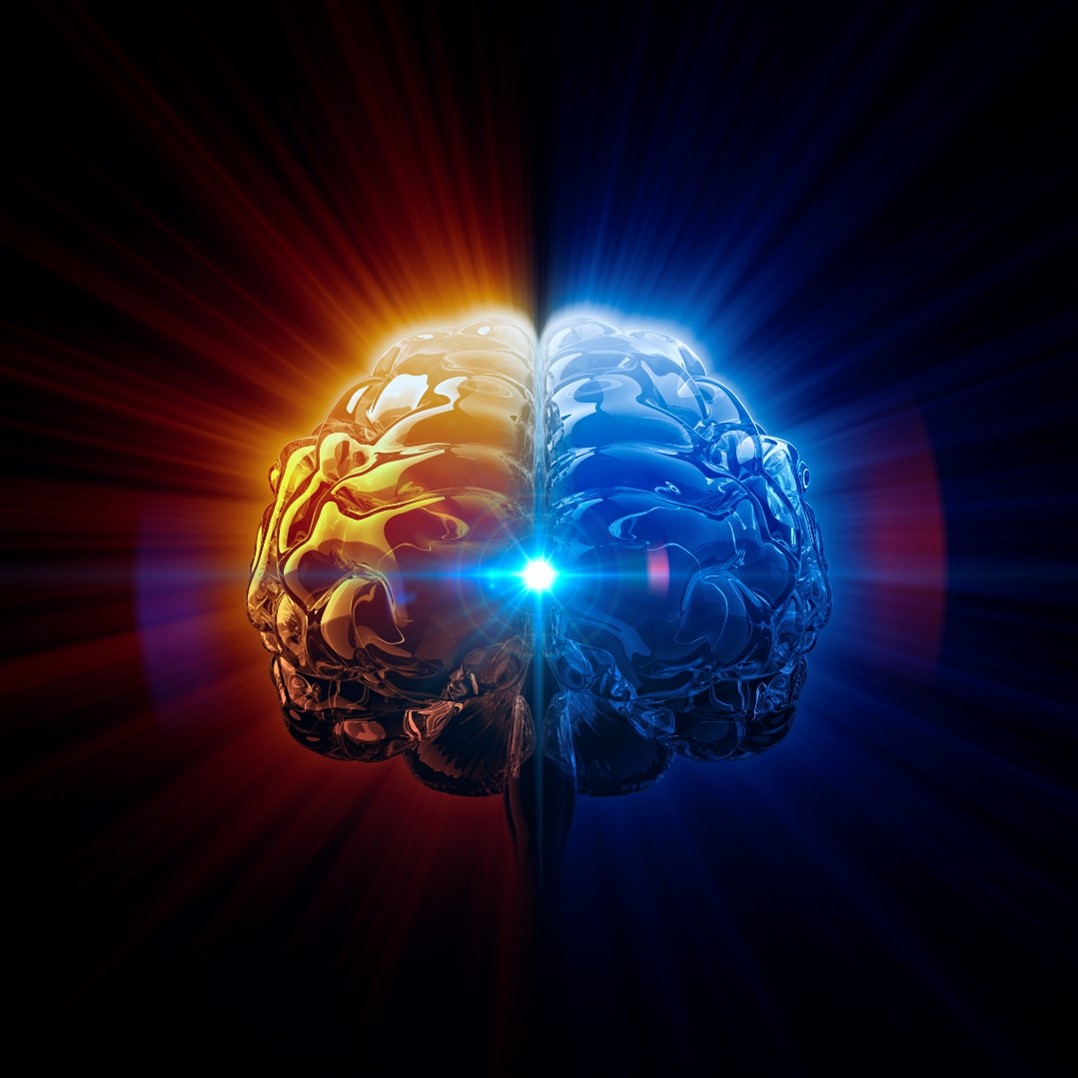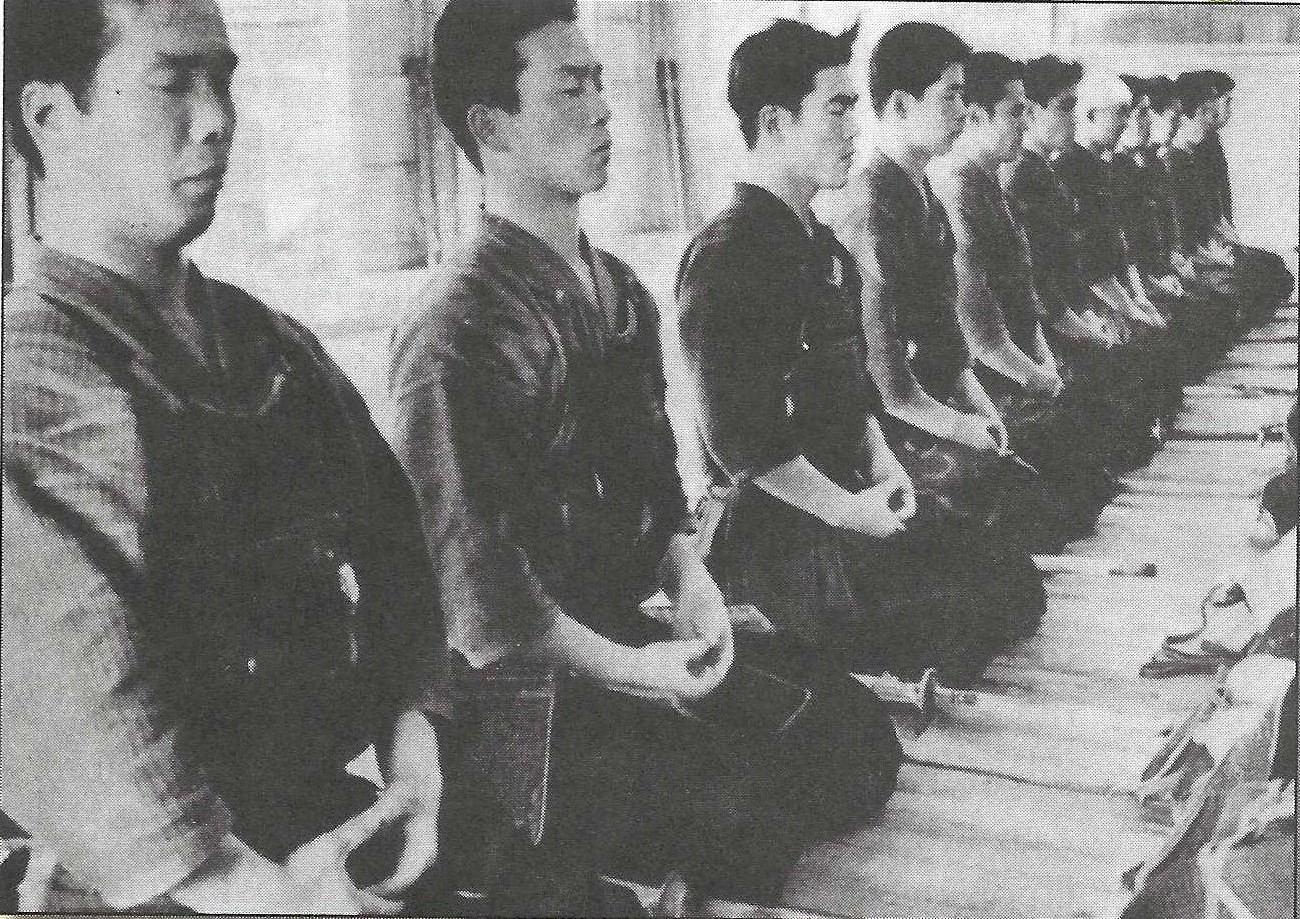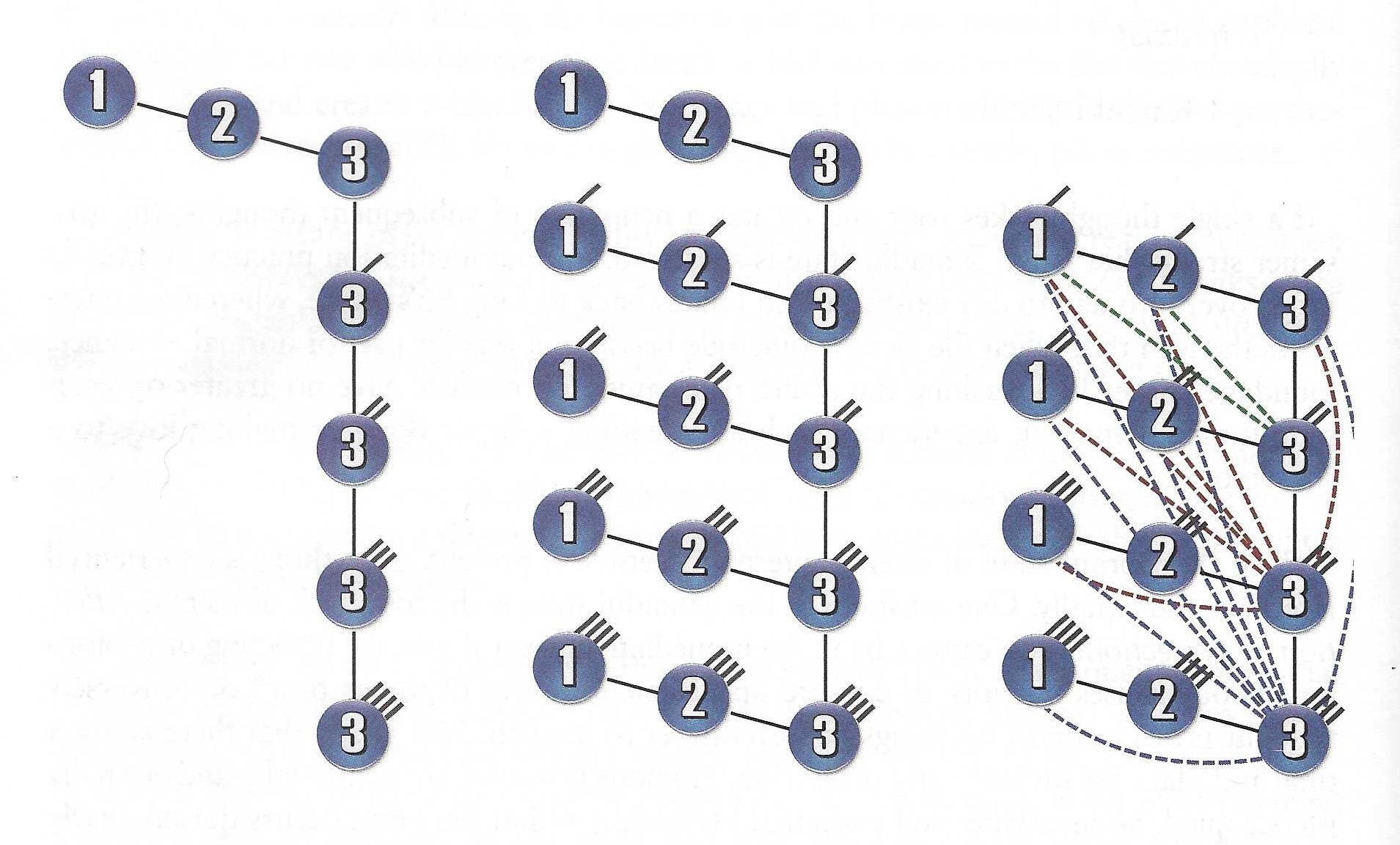
Mental hemispheres: the intuitive, artistic, right-brain/left-hand shares space with the logical, calculating, left-brain/right-hand. Intuition and artistic innovation arise in the gaps between thoughts.
It is a hard concept for folks to wrap their head around, this idea that the ideal headspace, the headspace meditational masters seek, is characterized by a lack of thinking, a lack of conscious thought, no internal dialogue. This seems a puzzling goal. Why would a rational, thinking person consciously seek a ‘blank’ headspace? That sounds lobotomized, disconnected from reality.
Most of us are quite impressed and attracted to our inner voice, the little man that resides in our brain. This inner voice, the thinker, the observer, takes on all the characteristics of another person, someone or something distinct from yourself. We give our inner voice the role of bon companion, devil’s advocate, cheerleader, stressful self-critic, and in many (most) cases a downright bad influence. Our inner voice gives us permission and encouragement to engage in bad behavior.
The inner person, the talker, it is all you. We spend all our time carrying on an ongoing and shifting dialogue with ourselves. Back and forth, the repartee is rapid, and we give the voice so much credence and assign it a gravitas that makes us forget that we are talking to ourselves. We can never know what we don’t already know. The inner voice, no matter how hip, cool, well spoken, or intelligent sounding, can never tell us anything we do not already know.
Why do we want to be thought-free?
Only when mentally silent can we perceive reality. Reality, life, does not occur in your head. Reality can only be perceived when the conscious Mind falls silent. The thinker, the voice, the little man inside our head, must fall silent. When this occurs, the mental fog lifts, revealing a world of startling clarity and color.
The present rushes past us as if we were standing in the middle of a raging stream. When thought free, reality presents itself: future tense melts into present tense and rushes past, receding into past tense, time and motion intertwined. All invisible when the thinker, the internal commenter is online and active.
Thought is the mental fog that obscures the perception of reality. Reality is perceived in the gaps between thoughts. Out of this same perception-enabling mental silence arises intuition and artistic creativity. The conscious mind functions far better when periodically taken off line, i.e., given a rest from its eternal, unceasing chatter. Actually, factually, being thought-free is the only time we are truly connected to reality.
Purposeful 'Mindless' Pursuits

ling po, 17th century zen master
Cleaning up cow manure, making love to the exquisite courtesan - all the same!
There is real value to being able to immerse yourself in an activity to the point that you lose all sense of time and self. You will do what it is you are doing far better, and with much greater concentration and focus. There is a tremendous psychological benefit to periodically practicing purposeful mindlessness.
Moku-san is formalized Zen meditation used before engaging in sport. It has been used in Japan for centuries. Here a gang of Purposefully Primitive Hard Men clear their minds of extemporaneous thought before bashing the hell out of each other with wooden boken swords. These men seek to achieve a mental alertness called "sword of the non-abiding mind" prior to Kendo practice. We rip a page from the book of Budo for our own Westernized purposes. Mushin no shin, the 'mind of no mind' seeks "the establishment of something that transcends mere technique; explainable as a spontaneous mind that embraces a sixth sense."

Think of the human mind as a muscle, Like any muscle, if it is overworked it becomes over-training and overtraining, as is the case with any muscle, leads to fatigue and performance degradation. The over-trained, over-worked, over-thinking brain becomes metaphorically overheated. The remedial solution is purposeful quietude; give the overactive mind some rest.
A mind that chatters ceaselessly eventually exhausts itself and an exhausted brain does not function nearly as well as a rested brain. Thought is self-perpetuating and by allow internal dialogue to continue unabated 24-7-365, mental burnout lies just around the corner. Humans instinctively realize this and this is why drugs and alcohol are eternally popular: both allow the individual to dampen and suppress thought and reality. By stupefying the senses, by chemically altering the functioning of the brain, mental relieve and euphoria are acquired. Anyone who has ever been drunk or high can attest to the fat that chemically altering the mind creates a pleasurable experience and pleasure is physically and psychologically addictive.
The desire to escape psychological reality and replace it with an altered reality is common and craved; always has been and always will be. Sufi Whirling Dervishes, Zen Monks, yoga aesthetics, sequestered Christian contemplative monks, Taoist priests, all seek to alter reality - though they would argue that they are amplifying reality not stupefying reality.
One common thread that ties the various holistic and natural contemplative methods together is that they all seek to silence the internal voice of conscious thought, one way or another. Thought creates a thin milky psychological layer that obscures reality. If thought is operating you are preoccupied.
When the internal voice grows silent, that thin continual sheen, the thought-chatter that obscures reality (and reality always unfolds in the instantaneous present) is scraped away. When the mind is silent and the senses engaged, you truly are able to see. Zen monks sit in formal meditation for upwards of twelve hours a day. In Zen meditation the idea is to quiet the mind without suppressing the mind and that presents a very tricky psychological dilemma. When thought finally falls silent the monks experience 'true original self.' The Zen brain, subjected to continual daily practice, eventually grows quiet and in that quietude an electric alertness emerges during which no thought arises. If thoughts do arise they are not 'clung to.' A thought might occur, but the reflective act of consciousness does not spring into action and examine or expand on the initial thought. And that is the end of it. No "thought chain" or "Nen sequence" occurs. The initial thought might arise, but the nen-chain does not take root. When a single though arises, no amplification or expansion occurs and the electric alertness reemerges. Crisp clarity returns. After a period of continual no-thought, a 'Samadhi' state occurs. Samadhi is inexplicable; words cannot describe a wordless state. If pressed it might best be described as an ecstatic state-of-being that happens when the brain becomes silent yet remains alert. A vibrant stillness envelopes the body as the "sense gates" become amplified. Hearing, seeing, tasting and feeling are heightened and remain heightened as long as conscious thought does not interfere with the delicate non-verbal state. Samadhi, heightened sense phenomena, rolls on unabated.

katsuki sekida
Moment after moment only the present comes and goes during the period of Samadhi, a continuous stream of the immediate present. Only in the precise instant of the immediate present can we be said to exist.
If a single thought takes root and creates a nen-chain of subsequent thoughts, the gossamer strand that is the Samadhi state is shattered. Formal meditation practice eventually filters over into day to day existence and relates back to Ling Po's quote, wherein he references the idea that when the electric quietude becomes a regular part of normal existence, mundane chores like washing the dishes or clean up manure have no create or lesser significance than peak experiences such as attending a Super Bowl or making love to a super model.
When the vibrant state of intense internal quietude is present, everything is experienced intensely and equally. One attribute of the Samadhi state is the total lack of mental reflection or projection. You cannot be in the immediate present if you are reflecting or projecting. Thought uses memory to conjure up "Remembrances of things past" or conversely thought projects ahead on things and events yet to happen. Not to say that there is not a time and place for memory and projection. Humans, however, are continually and eternally preoccupied, an unceasing and continual blathering within the brain occurs during nearly every waking moment. No activity is done without the "thinker" engaging in internal dialogue. People find that only when engaged in some intense activity does the thinker fall silent: sex or sport, life or death experience, something so exotic or dramatic that full attention is demanded. We have even coined a pop psychology phrase, "peak experience" to describe those undertakings or events so captivating and enthralling that the internal thinker, the verbal diarrhea, fall silent; trumped by events so intense that the individual stays in the immediacy of the exact present with every ounce of their being.
Is all this talk about internal dialogue mere arcane abstraction with no real relevance to Americanized fitness or athletics? Hardly, Sport masters need to be in the absolute present when applying their tradecraft.
Dogen Zenji, Krishnamurti and Thomas Merton, all the mystics and seers, inform us that the inky film of thought prevents you from being in the exact present. Of course drugs and alcohol can obliterate thought and with it the web of personality, but like going to the circus, sooner or later you have to come home. Athletes and improvisational jazz musicians are aware of the thought-free bliss of the immediate present. An athlete in the white hot immediacy of a competitive event has no time for conscious thought. Actually, conscious thought can be detrimental for the athlete.
Sekida's Zen Nen Chain Diagram describes passing and clinging thoughts.
1. Represents sensory input.
2. Represents the reflecting act of consciousness - the little voice in our head.
3. Represents clinging thoughts.
When a person, place or thing enters into our sensory radar screen, that is #1. When people, things or events pass into and then out of our perception, without thought amplification, that is #2 a passing thought. When we enter into internal mental discourse about the object of our mental focus, that is #3 clinging thoughts.

There is a problem with allowing 3rd Nen clinging thoughts to take root. When 3rd Nens are active, perception or the ever-unfolding instantaneous immediate present is impossible. The best psychological positioning is mental quietude combined with mental alertness. A thought-free mind is vibrant, engaged and amplifies the five senses. The factual reality of the immediate present emerges out of mental silence.
Krishnamurti encapsulated this psychological phenomena in his master work, "The Awakening of intelligence." He makes the case that when the unceasing internal voice finally becomes quiet, a whole new dimension of reality and existence is revealed: vibrant, exciting and wonderful. He states that the peak experiences of the Jazz musician, elite athlete or Zen Master can be experienced by all of us as we go about our day to day lives. We can improved our psychological well-being by consciously engaging in activities that cause the chatterbox to fall quiet. Pursuits that require intense concentration naturally cause the mind to fall silent. Art, music and sport can become activities that allow the mind to fall silent, but there are numerous activities that potentially allow you to "lose yourself." Some folks 'become selfless' working on their custom cars, doing carpentry, knitting, gardening or playing chess. Others achieve the electric alertness doing T'ai Chi or Qigong.

jiddu krishnamurti
The cessation of thought is the awakening of intelligence.
I personally seek to engage in a variety of activities in which I lose all sense of self. Intense physical training short-circuits and quiets the conscious chattering of the "observer" every single time. There is no way in hell the brain can be chit-chatting about "what's for dinner" or "how will the Redskins do this weekend" while underneath a 500 pound barbell performing backbreaking squat reps. Ditto for an intense game of racquetball, tennis or basketball. The lightning pace, the sheer physical exertion, makes sure there are no superfluous mental projections or reflections.
Do you engage in some sort of activity that requires that you reside lightly in the immediate present?
Does your reflecting or projecting internal voice mindlessly blather ceaselessly and endlessly?
Does the thin inky film of continuous chatter prevent you from experiencing the electric alertness of the immediate present?
Are you able to become lost in an activity?
For your own mental health you should seek activities that demand total and complete attention. If you want to renovate your physique, you will need to learn how to immerse yourself in hard training. Mental silence is an indicator that you have taken your training performance to the next level. Learn how to immerse yourself so totally and complete in an activity that thought falls silent of its own accord. Champion athletes and elite performers know and understand this. So should you!
As an added FREE BONUS download the Purposeful Primitive Proven Psyche Up Procedures called "The Tao of Fitness" to learn how to amp your performance. Also check out the posts below to learn more about how to better focus the mind.
Learn more about mental psyche check out our Mental Psyche Resource Page. Join the community sign up below to our newsletter and receive our FREE Planning and Periodization Guide. Please feel free to send us a question here or leave a comment below.
Want the inside training scoop?
Join The Community
Our email content is full of value, void of hype, never pushy, and always free. As a BONUS you will receive our FREE planning & periodization template to help you with your training goals.




